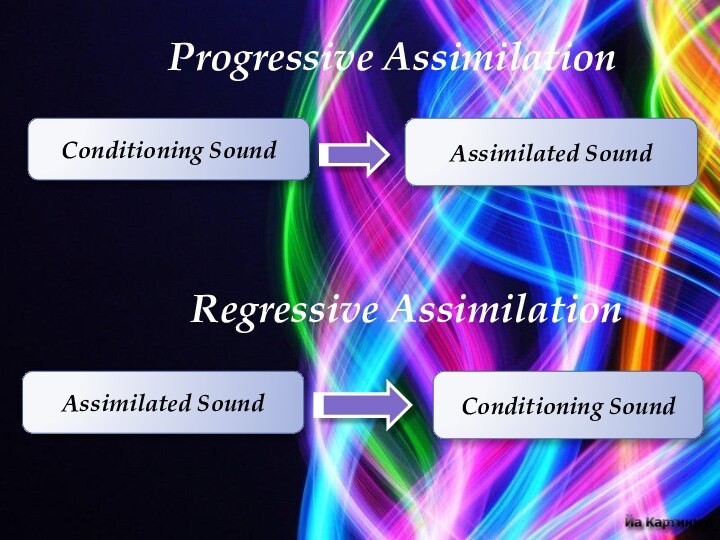Слайд 2
Language in everyday use is not conducted in
terms of isolated, separate units; it is performed in
connected sequences of larger units, in words, phrases and longer utterances.
And there are actually some remarkable differences between the pronunciation of a word in isolation and of the same word in a block of connected speech.
Though these changes are mostly quite regular and predictable, there is still problem of defining the phonemic status of sounds in connected speech. It happens because of the numerous modifications of sound in speech.
These modifications are observed both within words and at word boundaries.
Слайд 3
As we know, speech sounds influence each other
in the flow of speech. As a result of
the intercourse between consonants and vowels and within each class appear such processes of connected speech as
assimilation
accomodation
vowel reduction
elision.
Слайд 4
As it was mentioned above, speech sounds influence
each other in speech flow, thus becoming pronounced in
a different way. These modifications of speech sounds are observed both within words and at word boundaries. Such intercourse between sounds in connected speech is termed coarticulation» (the term was first suggested by a Spanish phonetician A. de Lacerda).
Coarticulation results in assimilation, when one of the sounds becomes fully or partially similar to the adjoining sound. The word «assimilation» is an example of this phenomenon. This Latin word is composed of the preposition «ad» — to, and the adjective «similis» alike, similar, ad-similatio — assimilatio: [ds>ss] ([d] under the influence of the following [s] was changed to [s]).
Слайд 5
More terminology…
The sound that changes is called the
assimilated sound or the target.
The sound that causes the
change is called the conditioning sound or trigger.
Two sounds that have the same place of articulation are called homorganic
Слайд 6
direction
degree of completeness
degree of stability
Слайд 7
Direction of Assimilation.
The influence of the neighbouring sounds
in English can act in a progressive, regressive or
reciprocal (double) direction.
When some articulatory features of the following sound are changed under the influence of the preceding sound, which remains unchanged, assimilation is called progressive.
When the following sound influences the articulation of the preceding one assimilation is called regressive.
Reciprocal or double assimilation means complex mutual influence of the adjacent sounds.
Assimilation
Regressive Assimilation
Conditioning Sound
Assimilated Sound
Assimilated Sound
Conditioning Sound
Слайд 9
Degree of Completeness.
According to its degree, assimilation can
be complete and incomplete.
Assimilation is called complete in the
case the two adjoining sounds become alike or merge into one. It always takes place when the two sounds differ only in one articulatory feature.
Eg. less shy ['les'∫ai > 'le∫∫ai].
Assimilation is called incomplete when the likeness of the adjoining sounds is partial as the assimilated sound retains its major articulatory features.
For example, the sonorants [w, 1, r] are partly devoiced when preceded by the voiceless [p, t, k, s, f, ð] within words: sweet [swi:t], place [pleis], try [trai].
Слайд 10
Degree of stability.
Many
assimilatory phenomena of older stages in the development of
the language have become obligatory in modern English, they may, or may not be reflected in spelling. Such changes which have taken place over a period of time within words are called historical, eg orchard (ort + yard) — ['o:tjəd>'o:t∫əd].
Besides there are a lot of widely spread but non-obligatory cases of assimilation which can be traced mainly at word boundaries, eg ten minutes ['ten 'minits >'tem'minits]
Слайд 11
Place of articulation
t, d > dental before
[ð, θ]: eighth, at the, said that
t, d
> post-alveolar before [r]: tree, true, dream, the third room
s, z > post-alveolar before [∫]: this shop, does she
t, d > affricates before [j]: graduate, could you
m > labio-dental before [f]: symphony
n > dental before [θ]: seventh
n > velar before [k]: thank
Слайд 12
The manner of articulation is also changed a
result of assimilation, which is illustrated by following types:
1.
LOSS OF PLOSION. In the sequence of two plosive consonants the former loses its plosion: glad to see you, great trouble, and old clock (occlusive consonants [p],[b],[t],[d],[k],[g] loose the plosion, when they are followed by another occlusives or affricates [tζ],[d ʒ] example: the dark garden”)
2. NASAL PLOSION. In the sequence of a plosive followed by a nasal sonorant the manner of articulation of the plosive sound and the work of the soft palate are involved, which results in the nasal character of plosion release: “sudden”, “not now”, “at night”, “Let me see”.(alveolar consonants [t]&[d] are followed by nasal consonants [n]&[m]).
3. LATERAL PLOSION. In the sequence of a plosive followed by the lateral sonorant [l] the noise production of the plosive stop is ghanged into that of the lateral stop: “settle”, “table”, “at last”.
Слайд 13
The voicing value of a consonant may also
change through assimilation. This type of assimilation affects the
work of the vocal cords and the force of articulation.
The vibration of the vocal cords is not something that can be switched on and off very swiftly, as a result groups of consonants tend to be either all voiced or all voiceless.
Consider the different endings of ‘dogs’ /dɒgz/ and ‘cats’ /kæts/, of the past forms of the regular verbs such as ‘kissed’ / kɪst/ and ‘sneezed’ /sni:zd/. In these cases the fact of the final consonant of a word being voiced or not determines the choice of whether the suffix will be voiced or voiceless. In the case of the suffixes for plural nouns, for the third person singular in the present simple, for regular verbs in the past simple and for the genitive the application of this rule is predictable, with only a few exceptions (e.g. leaf → leaves)
Слайд 15
The term accomodation is often used by linguistics
to denote the interchanges of ‘vowel + consonant type’
or ‘consonant + vowel type’, for instance, some slight degree of nazalization of vowels preceded or followed by nasal sonorants: never - men.
Слайд 16
LIP POSITION may be affected by the accommodation,
the interchange of consonant+ vowel type. Labialisation of consonants
is traced under the influence of the neighbouring back vowels (accommodation), e.g. pool, moon, rude, soon, who, cool. It is possible to speak about the spread lip position of consonants followed or preceded by front vowels [i:], [i], e.g. tea-beat, meat-team; feat-leaf, keep-leak; sit-miss.
Слайд 17
The position of the soft palate is also
involved in the accomodation. Slight nasalization as the result
of prolonged lowering of the soft palate is sometimes traced in vowels under the influence of the neighbouring sonants [m] and [n], e. g. and, morning, men, come in.
Слайд 18
Vowel reduction is a quantitative or qualitative weakening
of vowels in unstressed positions:
board – blackboard man –
postman
This means they are pronounced less
distinctly, often becoming simply a schwa
([ə]).
Schwa is the most common reduced vowel in English, and orthographically it may be denoted by any of the vowel letters:
The a in about.
The e in synthesis.
The o in harmony.
The u in medium.
Слайд 19
There are actually three levels of stress in
English words:
Primary stress: ‘bánal’ [beynәl]
Secondary stress: ‘banálity’ [benǽlәɾi]
No stress:
‘banál’ [bәnɑ́l]
The other sounds that can serve as the peak of reduced syllables are the syllabic consonants. The consonants
that can be syllabic in English are the nasals /m/, /n/, /ŋ/,
and /l/ (actually a dark l). For example:
The m in prism is sometimes a syllabic /m/.
The on in button is a syllabic /n/ in dialects that pronounce Intervocalic 't' as a glottal stop.
The word and in the phrase lock and key in more rapid speech is sometimes pronounced as a syllabic /ŋ/.
The le in cycle and bottle is a syllablic /l/.
Слайд 20
Elision is a complete loss of sounds, both
vowels and consonants. In informal speech we can lose
many sounds. The process cannot be neglected in defining the phonemic status of speech sounds. These phenomena represent the economy of energy from the part of the speaker. Usually the listener doesn’t even notice this because these changes don’t influence the meaning. The target of listener is usually to understand the meaning but sometimes the meaning can also be influenced, for example [z] can represent has, is, does, plural, possessive, third person singular.
Слайд 21
1. Loss of /h/ in personal and possesive
pronouns he, his, her, him and the forms of
the auxiliary verb have, has, had is wide-spread,
e. g. What has he done? /‘wat әz i d^n/
2./l/ tends to be lost when preceded by /ɔ/:
e. g. always, already, all right.
3. Alveolar plosives are often elided in case the cluster is followed by another consonant,
e.g. next day /‘neks ‘dei/, just one /‘dʒ^s ‘w^n/
4. Historical elision: write, know, knight.










![Modification of english consonants in connected speech Place of articulation t, d > dental before [ð, θ]: eighth,](/img/tmb/11/1078229/1cfe30cb6c575d29743aaae57033d4f2-720x.jpg)








































